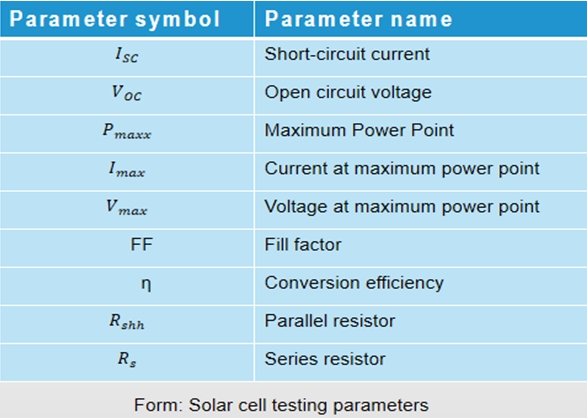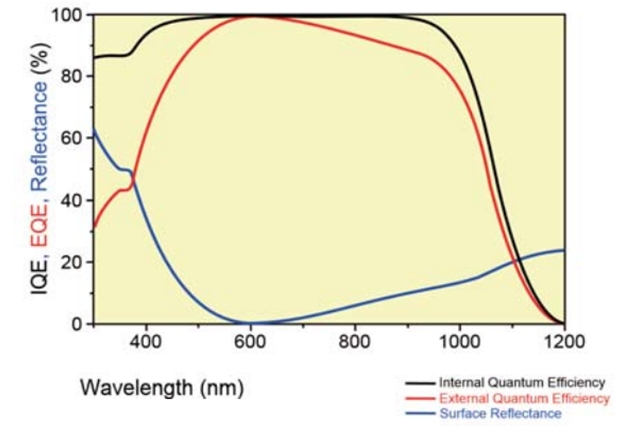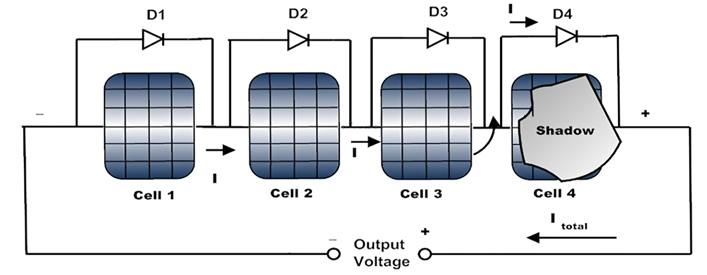

Solar Cell Test IV Characteristics Curve Measurement
Focus on semiconductor electrical performance testing
Position:Home > Solutions > Semiconductor discrete devices
After the solar cell is produced, it should be tested and characterized to reflect the performance of the obtained cell. The photoelectric characteristics of the solar cell, especially the analysis of the volt-ampere I-V characteristics, are important parameters for deriving the performance of the solar cell, mainly including the maximum current IMAX and voltage. VMAX, open-circuit voltage Voe, short-circuit current lsc, fill factor FF, and conversion efficiency n, etc., so, how to perform iv measurement of solar cell? Generally, we will use source measure meter for solar cell iv curve measurement.
Solar cell iv curve measurement, like many semiconductor and electronic device tests, needs to output voltage and measure current as fast as possible. Overall iv measurement time of solar cell is a function of charge time, measurement time, discharge time, and setup and processing test time. Traditional power supplies can only output voltage or current, but cannot absorb energy as a load, while a source measure unit(SMU) is a precision instrument that can provide complete four-quadrant operation. When working in the 2nd and 4th quadrants, it can As a sink (load) to absorb energy, when working in the 1st and 3rd quadrants, it can output energy as a source, and can simultaneously measure voltage, current and resistance in source or sink mode. A source measure meter (SMU) combines the functions of a current source, voltage source, ammeter, voltmeter, and electronic load, and can easily switch between these different functions. This makes it possible to measure the I-V characteristics of solar cells independently without using any other equipment support. This will greatly shorten the time of iv measurement of solar cell, simplify the overall test system design, and improve usability.
In addition to being able to output and measure the voltage or current output of the solar cell very accurately, the source measure unit (SMU) also has a consistency measurement feature that can limit the voltage or current output to prevent damage to the solar cell.

Since 2015,PRECISE has been committed to the research of source measure units,and has successively launched products such as high-precision source measure meters and plug-in source measure meters,and has cooperated with well-known manufacturers in the industry to create scientific research-grade single-channel and multi-channel solar cell iv curve measurement. The solar cell I-V test system provides reliable tools for the research, quality inspection and application of photovoltaic devices, helping researchers save time. At the same time, different selection configurations are provided to meet the test requirements of solar cell I-V measurement with different power and accuracy.
The most important measurement standard for solar cells is the photoelectric conversion efficiency (PCE), which includes specific performance parameters such as fill factor (FF), open circuit voltage (VOC), and short circuit current (JSC).

In the photovoltaic performance testing of solar cells, quantum efficiency contains a lot of information such as the photovoltaic conversion ability of solar cells. It can not only reflect the quality of the materials in each layer of the solar cell, but also reflect the quality of the anti reflection film, radiation damage, and various interface layers.
Spectral Rsponse (SR): Refers to the ability of incident light energy of different wavelengths to be converted into electrical energy, usually defined as the ratio of output current to incident light power:R(λ)=I(λ)/P(λ).
External Quantum Efficiency (EQE): The ratio of the number of electrons generated from a solar cell per unit time to the number of photons irradiated on the surface of the solar cell per unit time:
EQE(λ)=1240*R(λ)/λ.
Internal Quantum Efficiency (IQE): The ratio of the number of electrons generated from a solar cell per unit time to the number of photons absorbed by the solar cell per unit time:IQE(λ)=EQE(λ)/1−Reflectance(λ).

At present, the efficiency of perovskite solar cells is constantly improving, but the stability of perovskite materials seriously affects their commercialization process. According to the international aging testing standards for photovoltaic modules (IEC61646, 2008), photovoltaic devices must be able to maintain an initial efficiency of over 90% after continuous operation for 1000 hours under conditions of 85% humidity and 85 ℃ temperature.
Hot spot effect: Solar cells are generally composed of multiple battery modules connected in series or parallel. In the series branch, the energy generated by other illuminated solar cell components may be consumed as a load due to internal defects or external obstruction of the battery cells. The shielded solar cell components will generate severe heat and be damaged at this time.
Bypass diode: refers to a diode connected in parallel between the positive and negative terminals of a solar panel, which can effectively prevent the burning of silicon cells due to thermal spot effect. It is an important component of photovoltaic solar modules, and the quality of bypass diodes directly affects the power generation and safety of photovoltaic power plants.

PID effect (Potential Induced Degradation),the direct harm of PID to components is that a large amount of charge accumulates on the surface of the battery cells, exacerbating the passivation effect on the surface of the battery cells, resulting in a decrease in the filling factor, open circuit voltage, and short circuit current of the battery cells. The power attenuation of the battery components can reach up to 50%.
The single-channel solar cell I-V measurement system takes the PRECISES series and HCP series digital source measure meters as the core, and is equipped with a 3A-level solar analog light source, a test sample table, and a I-V test software.
PRECISE S series source measure unit is a high-precision, large dynamic range, digital touch source measure unit built by PRECISE for many years. It integrates multiple functions such as auxiliary input and output of voltage and current, and measurement. The maximum voltage is 300V, the maximum current is 1A, and it supports four-quadrant operation. It is suitable for I-V measurement of small area and low power solar cells. The HCP series has a maximum DC current of 30A, a maximum pulse current of 100A, and a maximum voltage of 50v, suitable for solar cells that require high current testing.
| Model | Voltage Range | Current Range | Accuracy |
| S series | 30/100/300V | 1A | V:0.1% I:0.1% |
| HCP series | 50V | 30A/50A/100A |

The reason why the general PRECISE source measure meter can perform solar cell I-V measurement well is because the PRECISE source measure meter supports 4-wire measurement (remote sensing), which can avoid the voltage error caused by the residual resistance of the test lead. Measurements made over a 2-wire connection can be seriously inaccurate when the resistance being measured is not much different from the resistance of the test leads. A 4-wire measurement uses one pair of leads to drive the current and the other pair to monitor the voltage. This removes the resistance effect of the cable so that only the voltage drop across the solar cell is measured. In addition, the PRECISE Source measure unit 4-wire measurement design can maintain the voltage between the high and low sensing points at the specified voltage Vset, thus ensuring that the user can accurately measure the solar cell under the specified measurement conditions. Enables you to accurately and easily measure solar cell iv characteristics, including short circuit current Isc, open circuit voltage Voc and maximum power point Pmax.
The PC software performs automatic control for solar cell iv measurement equipment. With automatic scanning, data acquisition and parameter calculation, directly display the results of open circuit voltage Voc, short circuit current lsc, short circuit current density Jsc, maximum power voltage Vmpp, maximum power current lmpp, fill factor FF, etc., chart files are automatically generated and displayed; a variety of Format data and picture backup and print output function, support Excel, ASCll, XML format; report printing function, automatically generate a complete solar cell iv characteristics measurement report.

In recent years, perovskite solar cell has attracted much attention because of its record high efficiency and low manufacturing cost. The main bottleneck affecting the commercial application of perovskite solar cell is its long-term stability, especially the stability under the combined action of light and light + heat. At present, the commonly used working stability test method of perovskite solar cell is to place the battery under 1 sun standard light irradiation, continue the maximum power point tracking (MPPT), control the battery temperature to about 50°C, and conduct photoaging test. The normal test time is 1000 hours. It is unacceptable to perform the light aging test under 1 sun. Therefore, it is necessary to perform a faster accelerated aging test under higher light intensity (>1 sun).
PRECISE is tailor-made for perovskite solar cell research workers—a powerful and complete multi-channel perovskite solar cell stability test system. The light source adopts long-life white LED lamps that can output 1-4 sun equivalent light intensity. There are various ways to control the temperature of the battery (-40-150°C) and control the ambient atmosphere of the battery (N2, dry air, constant temperature and humidity, etc.), so that multiple groups of perovskite solar cells can be tested for long-term stability at the same time. In addition to the traditional MPPT mode, constant voltage (such as open circuit voltage) and constant current aging (such as short circuit current) modes are added to increase the flexibility of stability research, and a powerful data analysis software is integrated to view and compare different samples in real time various performance indicators.
The system is mainly composed of hardware and software. The hardware includes host computer, high-precision source measure meter, LED light source and software. Each source measure meter independently controls a battery, so that real-time dynamic MPPT control of each battery can be realized, instead of one source measure meter controlling multiple batteries in turn; the digital source measure unit can use PRECISE S series high-precision source measure meter or CS series high-precision source measure meter Precision plug-in source measure meter products.
| Model | Type | CH | Voltage Range | Current Range | Accuracy |
| S100/200/300 | bench | 1 | 30V/100V/300V | 1A | V:0.1% I:0.1% |
| CS100/200/300 | plug-in | 1 | 30V/100V/300V | 1A | |
| CS400 | plug-in | 4 | 10V | 200mA |
This solution uses a combination of multiple PRECISE S series source units to build a perovskite solar cell stability multi-channel test system. The voltage range of the S series source measure meters is 300µV~300V, and the current range is 100pA~1A, which can take into account most perovskite solar cells and small modules. For testing, the number of source measure meters determines the number of channels.
This solution mainly adopts PRECISE CS plug-in source measure unit (CS1010C host + CS100 sub-card/CS400 sub-card) to form a multi-channel test solution, which has the characteristics of high channel density, strong synchronous trigger function, and high efficiency of multi-device combination.
CS1010C mainframe: adopts a custom frame, the backplane bus bandwidth is up to 3Gbps, supports 16 trigger buses,meets the needs of multi-card devices for high-speed communication,and has slots that can accommodate up to 10 cards;
CS100 sub-card: a single-card single-channel sub-card with four-quadrant working capability,a maximum voltage of 30V,a minimum current of 100pA,an output accuracy of 0.1%, and a maximum power of 30W;with the CS1010 host,a maximum of 10 test channels can be built;
CS400 sub-card: It is a single-card four-channel sub-card,the 4 channels in the card share the same ground,the maximum voltage is 10V,the maximum current is 200mA,the output accuracy reaches 0.1%, and the maximum power of a single channel is 2W; it can build up to 40 test channels with the CS1010 host.

LED light source
It adopts high-stability and long-life imported super-large lighting area LED lamp bead array light board, supports simultaneous light test of multiple small batteries and small modules, the maximum light board area can support 350*350mm², the effective lighting area is 300*300mm², and the stability is 10000 hours Decline <2%.
system software
The system test is mainly divided into four main test interfaces: I-V test, MPP tracking, V-t test and I-t test.
I-V test: start by measuring the open circuit voltage VOC of the battery, and collect voltage values evenly by setting the scanning voltage interval (can be set). Gradually increase the voltage (forward scan)/decrease (reverse scan); wait for each voltage point to stabilize at t1, read the current value at that point, and collect and record basic data and curves of current changes with voltage.

Picture 8 I-V forward scanning curve

Picture 9 I-V reverse scanning curve
MPPT tracking: Using the perturbation algorithm, the position of the maximum power point of the solar cell is constantly fed back and corrected during the test, so that the battery can be kept in the maximum power discharge state for a long time, and the output power is monitored in real time during the discharge process, and the test duration and scan interval can be set. Collect and record the value of the maximum power time change and the P-t curve. During MPPT tracking, regularly scan the I-V curve of the seedling (for example, once every 10 hours) within the total test time (for example, 1000 hours), and record four key performance indicators such as battery Voc, lsc, FF and PCE over time Changing scenarios (100 data points over 1000 hours).

Picture 10 P-t curve during MPPT tracking
V-t test: Like MPPT, it is necessary to periodically scan I-V to obtain the change of four key performance indicators over time, but the solar cell is filled in a constant voltage mode between regular I-V scans; that is, the constant voltage mode is adopted through the source measuring unit, Control the load of the source measuring meter at a fixed V or dynamic Vmpp, and monitor the changes of I-t and P-t of the device.

Picture 11 V-t test curve

Picture 12 P-t test curve
I-t test: Like MPPT, it is necessary to periodically scan I-V to obtain the change of four key performance indicators over time, but the battery is in a constant current mode between regular I-V scans. That is, the source measure meter adopts constant current mode to control the load of the source measure unit at a fixed I or dynamic lmmp, and monitor the changes of V-t and P-t of the device.

Picture 13 I-t test curve

Picture 14 P-t test curve
In short, Wuhan PRECISE source measure unit (SMU) is the best solution for characterizing the I-V characteristics of solar cells. Its wide current and voltage measurement range can provide excellent measurement performance for scientific research and production. Combined with the solar simulator and dedicated host computer software, it supports automatic scanning of I-V characteristic curves and measurement of open circuit voltage, short circuit current, maximum power, fill factor, conversion efficiency and other parameters, which can greatly simplify solar cell I-V curve measurement and improve efficiency. Solar cells can be characterized more precisely and easily than ever before.
